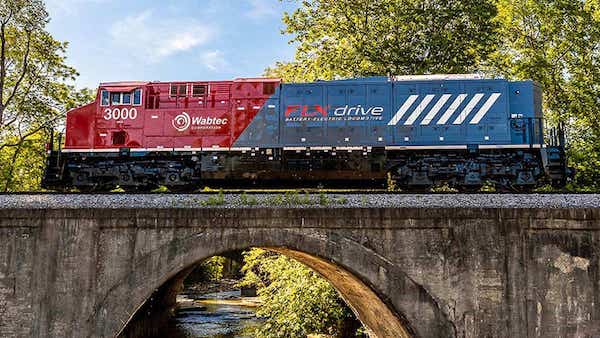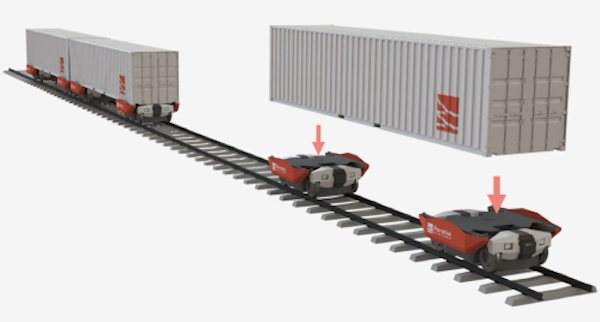While electric cars have become increasingly mainstream over the last decade, the freight rail industry has not seen the same push to electrify. According to Berkeley Labs, electrification efforts for freight trains have not been a priority because they only account for about 2% of U.S. transportation emissions. What many may not realize is that the U.S. rail freight industry is already halfway electrified, as nearly all diesel freight trains run on diesel-electric drives. But with the dramatic decline in both batteries and renewable energy, some see the freight rail sector as a prime target for full electrification.
Trains play a significant role in moving goods throughout the U.S., particularly heavy freight such as coal, lumber, and ore. According to the Federal Railroad Administration, 28% of U.S. freight is moved around the country by rail. However, trucks still move a greater tonnage of goods than rail. That’s despite the fact that railroads are on average three to four times more fuel-efficient than trucks. Medium and heavy duty trucks also account for about a quarter of all U.S. transportation sector emissions, according to the Environmental Protection Agency (EPA), but a single freight train can replace several hundred trucks.
Diesel-electric trains have been around since the 1920s, and began to replace steam trains in the 1930s since they performed better and helped cut labor and maintenance costs. At that time, using diesel engines to generate power for the motors on trains was cheaper than trying to develop fully electric trains due to high electricity costs. Now, a century later, we are at a point where the price of electricity is competitive with diesel. At the same time, battery energy densities have tripled since 2010 while battery pack prices have declined by nearly 90%.
Pennsylvania-based Wabtec is one of those betting that the future is electric. They introduced the new FLXdrive 100% electric locomotive in November, which the company says is the world’s first fully battery-electric freight train. Wabtec has already taken orders from the worlds top two mining companies-Rio Tinto and BHP-as well as one each for Roy Hill and Canadian National Railway (CN), all of which will be delivered in 2023. CN will use its FLXdrive at its Bessemer & Lake Erie Railroad Company subsidiary in western Pennsylvania. The plan is for the FLXdrive to operated a 139-mile route from the suburbs of Pittsburgh to Conneaut, Ohio. However, it won’t be a 100% fully electric system.
The FLXdrives are paired with diesel locomotives, making the whole train is essentially a hybrid. Still, Wabtec estimates a fuel savings of 30% from the hybrid configuration. A pilot program carried out by BNSF in 2020 used the FLXdrive to haul freight for 13,000 miles worth of trips between Stockton and Barstow, California. The FLXdrive shared pulling duties with diesel locomotives, reducing overall fuel consumption by -11%. The FLXdrive can be charged at a rail station and then recharged along the way using kenetic energy generated by braking. The next-gen versions set for delivery next year will be even more powerful, bumping battery capacity from 2.4 megawatts hours to 7 megawatt-hours, which is “100 times the power and energy within a Tesla,” according to Wabtec.
Speaking of Tesla, three former engineers from the companies SpaceX division are also looking to electrify freight trains and make them fully autonomous. Their company, called Parallel Systems, is working on a prototype that utilizes autonomous rail vehicles capable of carrying one standard shipping container.
Parallel’s vehicles are each self-powered but the company says they work best as a pair. CEO and founder Matt Soule told CNBC that the company envisions a “platoon” of 10 to 50 self-powered freight cars linked together but capable of splitting off to individual destinations en route. That compares to traditional freight trains that can be up to 200 cars or more. The biggest disadvantage of such long trains is that they require very large terminals to load and unload the freight. Parallel says its system would allow for the use of smaller and less expensive terminals closer to shippers and customers. It also says its model would make container moves by rail financially feasible for shorter distance than the 500 miles currently considered the shortest economical move for railroads.
Union Pacific and other major rail operators have expressed early interest in Parallel’s system. However, it is not something that can be integrated seamlessly into the existing U.S. rail freight system. Union Pacific CEO Lance Fritz said, “Candidly there are a lot of hurdles in front of that technology for deployment. Having said that, it could potentially be a game-changer if it proves out to be effective and workable.” Parallel says the system is unlikely to be ready before 2025. Still, the company just came out of stealth with $49.55 million in funding for the construction of the vehicles. (Sources: CleanTechnica, Nature, CNBC, Berkeley Lab)










With electric cars becoming more and more commonplace, it shouldn’t be a surprise to anyone that freights could also implement those same elements, becoming more environmentally friendly and efficient to boot.